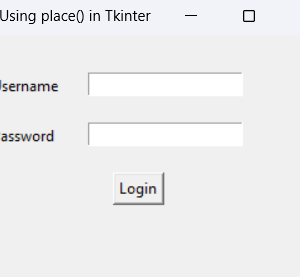Learn how to use the Tkinter Scrollbar in Python.
This beginner-friendly guide walks you through step-by-step with code examples and explanations.
Contents
Tkinter Scrollbar Tkinter Scrollbar
What is a Scrollbar in Tkinter?
Scrollbars in Tkinter are those little bars that help you scroll when content overflows.
Imagine you have a huge list or a long text area.
If it doesn’t fit in the window, you need a way to see the rest.
That’s where scrollbars come in.
They don’t belong inside widgets like Text or Listbox.
Instead, they are separate widgets that you connect to scrollable ones.
Basics of Tkinter Scrollbar Widget
To make a scrollbar in Tkinter, you use ttk.Scrollbar.
It’s simple and modern-looking.
The basic syntax looks like this:
ttk.Scrollbar(master=None, **kw)Here’s what it means:
master: Where the scrollbar goes (like a Frame or root window).**kw: Extra options, like direction (orient), action (command), style, and more.
Common values:
orient=tk.VERTICALortk.HORIZONTALcommand=some_widget.yvieworxview
Tkinter Scrollbar
How to Create a Vertical Scrollbar
Let’s create one step by step.
v_scrollbar = ttk.Scrollbar(
scrollable_widget,
orient=tk.VERTICAL,
command=scrollable_widget.yview
)What’s happening here?
scrollable_widget: This could be aText,Listbox, orCanvas.orient: We pickedVERTICALfor up-down scrolling.command: This tells the scrollbar what to control.
Now, we also need the widget to tell the scrollbar what’s visible.
We do that like this:
scrollable_widget['yscrollcommand'] = scrollbar.setNow both the scrollbar and widget are in sync.
Making Widgets Scrollable with Scrollbar
Let’s break it down.
Link Scrollbar → Widget
Use command=widget.yview
Link Widget → Scrollbar
Use yscrollcommand=scrollbar.set
Both sides need to talk to each other for a smooth scrolling.
Adding a Scrollbar to a Text Widget With Example
Here’s a working example:
import tkinter as tk
from tkinter import ttk
root = tk.Tk()
root.title("Tkinter Scrollbar")
frame = ttk.Frame(root)
frame.pack(padx=10, pady=10, fill=tk.BOTH, expand=True)
v_scrollbar = ttk.Scrollbar(frame)
v_scrollbar.pack(side=tk.RIGHT, fill=tk.Y)
text = tk.Text(frame, height=8)
text.pack(side=tk.LEFT, expand=True, fill=tk.BOTH)
text['yscrollcommand'] = v_scrollbar.set
v_scrollbar.config(command=text.yview)
text.insert(tk.END, "\n" * 20)
root.mainloop()

How it works:
- We put both the
TextandScrollbarin aFrame. - The scrollbar is packed to the right, filling vertically.
- The text widget is on the left and expandable.
- We connect both using
yscrollcommandandcommand.
Now, when you run it, the scrollbar works perfectly.
Horizontal Scrollbars
Sometimes, your content stretches sideways instead of down. Maybe it’s a wide table, long line of code, or big image. That’s where horizontal scrollbars shine.
How to Add a Horizontal Scrollbar
Let’s tweak our earlier example to include one:
import tkinter as tk
from tkinter import ttk
root = tk.Tk()
root.title("Horizontal Scrollbar Example")
frame = ttk.Frame(root)
frame.pack(padx=10, pady=10, fill=tk.BOTH, expand=True)
# Text widget
text = tk.Text(frame, wrap="none", height=8, width=40)
text.pack(side=tk.TOP, fill=tk.BOTH, expand=True)
# Horizontal scrollbar
h_scrollbar = ttk.Scrollbar(frame, orient=tk.HORIZONTAL, command=text.xview)
h_scrollbar.pack(side=tk.BOTTOM, fill=tk.X)
text.config(xscrollcommand=h_scrollbar.set)
# Add sample long line
text.insert(tk.END, "This is a very long line of text that will need horizontal scrolling. " * 5)
root.mainloop()

What’s New?
- We added
wrap="none"to theTextwidget. This disables auto line wrapping so the line can scroll horizontally. - We packed the horizontal scrollbar at the bottom (
side=tk.BOTTOM) and filled it horizontally withfill=tk.X. - We connected
xviewandxscrollcommandjust like we did with vertical scrolling.
Now you can scroll left and right easily.
Conclusion
Using scrollbars in Tkinter might look a little tricky at first—but once you get the hang of it, it’s super simple.
Let’s recap the key steps:
- Create a
Scrollbarwidget. - Set orientation: vertical or horizontal.
- Link the widget to the scrollbar using
commandandyscrollcommandorxscrollcommand. - Pack them properly inside a
Frame.
With scrollbars, your GUI apps become way more user-friendly. Whether you’re building a text editor, a file browser, or just displaying a lot of data—scrollbars will make your layout clean and accessible.
If you’re feeling adventurous, try combining both horizontal and vertical scrollbars with a Canvas widget. It gives you full control over scrolling content in any direction.
That’s it! You now have a strong foundation for using the Tkinter Scrollbar widget like a pro.

